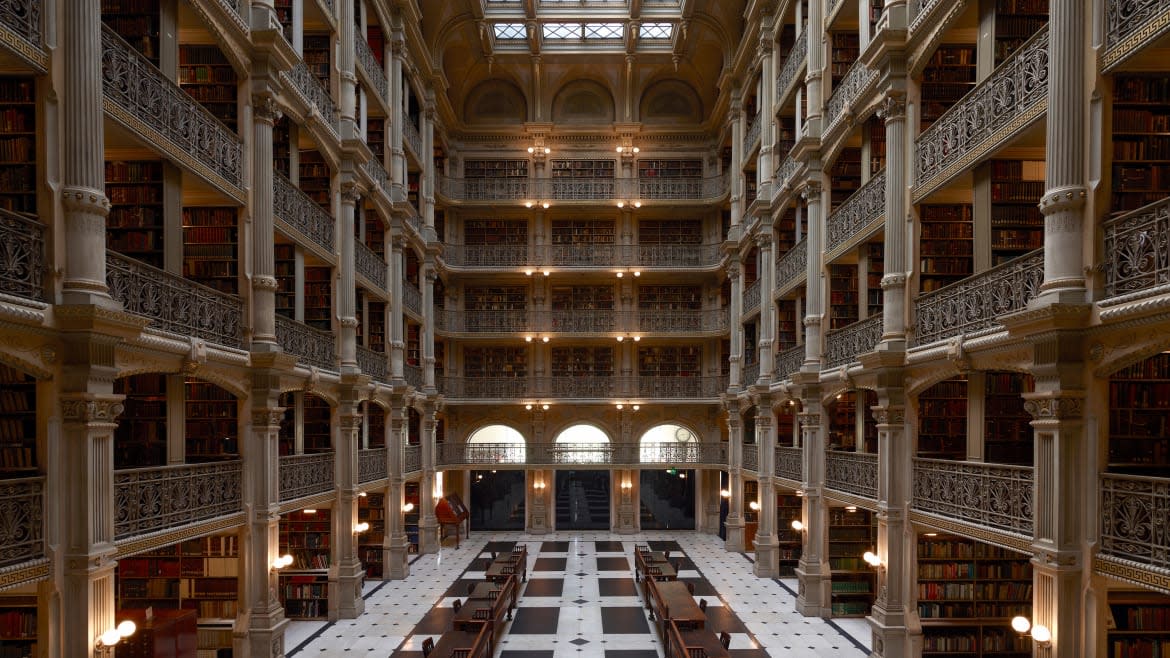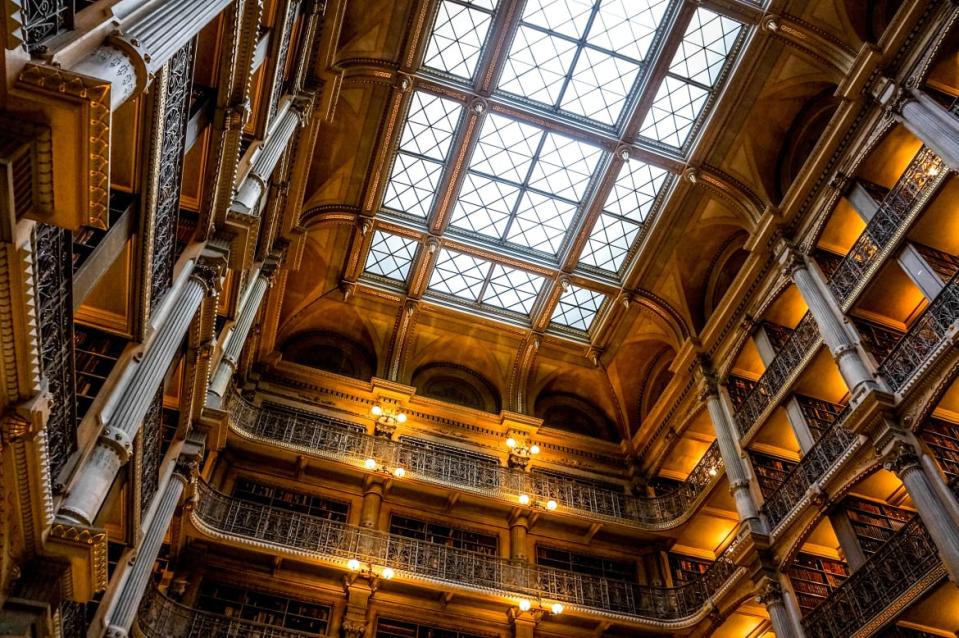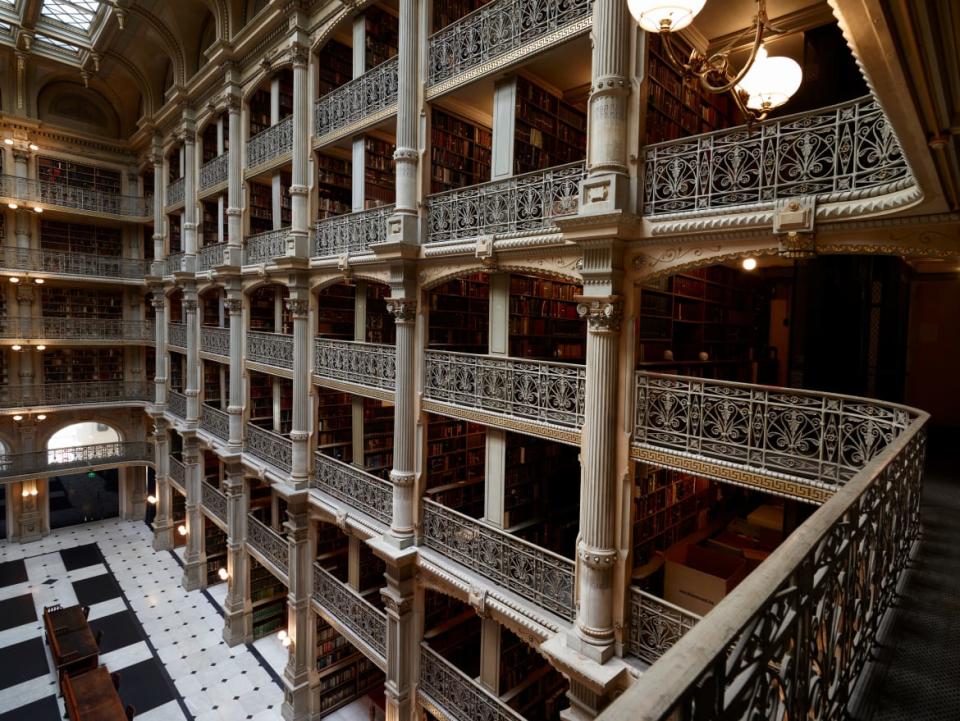The World’s Most Beautiful Libraries: Peabody Library

Awe-inspiring doesn’t begin to describe the threshold between the real world and the Alice in Wonderland proportions of the atrium at Baltimore’s George Peabody Library. For the second installment in The Daily Beast’s deep dive into the World’s Most Beautiful Libraries, our focus is on a domestic Gilded Age marvel, an absolute treasure that is as powerful as the knowledge contained therein.
The immensity is baffling and disorienting. In the grand reading room, which soars to 61 feet, the tallest person is dwarfed. Even the furniture, though designed specifically for the space, looks as though it belongs in a dollhouse. The towering stacks are cast iron but their substance is belied by their delicate gracefulness. The steampunk eccentricity is suggestive of industrial, celestial railroad.
Often touted as one of the most beautiful libraries in the world, and appropriately nicknamed the “Cathedral of Books,” the Peabody Library was built in 1887 under the direction of architect Edmund G. Lind, who lit the famous five verdigris tiers with a dazzling glacial skylight. It’s hard to believe that the twining and climbing ionic columns, railings, stairwells, and floors of the grand reading room were once molten iron poured into a mold and left to cool. Yet, the effect is as intricate as Parisian lace.
The spirit of Beaux-Arts architecture defies the specificity of time and place. Large slabs of black and white marble that cover the floor and fanciful parlor globe sconces keep the room from feeling weighed down by the metal scaffolding. But, the Gilded Age tradition of really going over the top isn’t lost. Palmettes, a classic element in Greek vases, are central to the railings. Pillars and arches are among the ruins in Rome and pendant ornamentation surrounding the skylight is a feature of Notre Dame. The design elements conspire to create the historicist style that reminds us of great literary civilizations.
The library is now home to 300,000 volumes comprising the Johns Hopkins University special collections, and remains open to the public, as was philanthropist George Peabody’s intention when he gave the people of Baltimore “an extensive library to be well furnished in every department of knowledge and of the most approved literature, which is to be maintained for the free use of all persons who may desire to consult it, and be supplied with every proper convenience for daily reference and study.”

Long before Andrew Carnegie became the Johnny Appleseed of public libraries, Peabody was on the case. Born in 1795 in South Danvers, Massachusetts (the city was later renamed in his honor), Peabody was one of seven children. He grew up poor, never finished school, and when his father died, he went to work in his brother’s shop to help support his mother and his other siblings. The man who would earn the unofficial title of the Father of Philanthropy never forgot the privations of his youth, which inspired both his thrift and his generosity. In 1816 he moved to Baltimore and got into the dry goods business, then became an importer and exporter, dealing mostly with Europe. In 1837, he moved to London, where he enjoyed often rocky but ultimately vast success as a financier. Upon his retirement, his shares went to J.P. Morgan Sr., the junior partner in the business. Morgan Stanley, JP Morgan Chase, and Morgan, Grenfell, & Co., now part of Deutsche Bank, can all trace their roots back to Peabody. He had no wife, and no heirs, but there may have been a mistress in England with whom he had a daughter. As a Quaker, giving back to the community was immensely important. In today’s currency, he gave more than $158,000,000 in acts of munificence with great emphasis on education, and no city benefitted more than his adopted hometown of Baltimore.
The most beautiful buildings in the world are built for God and books, even if it seems like no one reads them or worships anymore. Deciding what’s special at the Peabody falls to Curator Paul Espinosa.
Behind a wall of glass at the far end of the library is the man with the key to the inner sanctum, and it’s his full-time job to help navigate the library. On our way to the rare books room, which is in a corner room up a few flights of stairs, I looked to my right and notice the Ben Franklin titles—not first editions, but old nevertheless and are accessible to everyone.
“This is our rare book room,” he said as we entered a small room with remarkably high ceilings stuffed with books. “This is where we keep the older materials. The cutoff is 1700s. Everything before then is in this room.”
The cutoff isn’t absolute. There are a few exceptions for more recent irreplaceable treasures. Espinosa pulled out a first edition of Charles Darwin’s On the Origin of Species (1859), still remarkably intact with its original binding. He pointed out how rare it is to find a first edition with the original binder’s ticket and adverts publicizing Darwin’s other books (the title page reveals that the author had only a Masters of Arts degree).
Espinoza turned to the book’s final paragraph, a passage that proves Darwin to have been a diplomatic stylist who knew that his was a paradigm-shifting book. As he eased readers from biblical creation to science, he left some room for God and spirituality.

“There is grandeur in this view of life, with its several powers, having been originally breathed into a few forms or into one; and that, whilst this planet has gone cycling on according to the fixed law of gravity, from so simple a beginning endless forms most beautiful and most wonderful have been, and are being, evolved.” So, Darwin makes sure that God’s creation gets its due, but Darwin’s theory, literally, has the last word. And the sight of that final “evolved” as it originally appeared on the page packs a punch.
To demonstrate the craft of handmade bookmaking at its height, Esposito showed me a book of hours crafted by monks in the mid-15th century. The pages are vellum—calfskin scraped so thin that it’s almost translucent. Each page has wide margins at its sides and at the bottom, and these margins are tied to the mechanics of writing: where the ball of the hand sits and how it travels as it writes.
The monks who produced this one-of-a-kind book about the size of a digital tablet reader were ironically contemporaries of Gutenberg, but their respective efforts might as well have been a millennium apart. Books of hours were unique, individual works of art created for the glory of God, celestial datebooks meant to mark and commemorate holy occasions: The calendar in the front of the book Espinosa presented shows saints’ days and days of feasting and fasting, with the dates of their celebration lettered in red ink: it’s where the phrase “red-letter day” comes from.
The library as time machine: Esposito fast forwards to the 19th century and shows me a book that could only have been produced with the technology of its era: Eadweard Muybridge’s Animal Locomotion: An Elecro-Photographic Investigation of Consecutive Phases of Animal Movements, first published in 1887. Most of us could not afford to buy this exquisitely produced book today. Individual plates sell for as much as $1,500 dollars. And no wonder: the printing is astonishing, and the pictures themselves somehow still amaze us (imagine the images of a flip-book laid in a line). There are photographic series showing women carrying laundry, men playing leapfrog, pretty much any and every animal or human activity that can be isolated into their sequential movements. For his photographs of humans, Muybridge was given access to the patients of a Philadelphia mental asylum. But horses in motion were his first subjects. Muybridge lined cameras up with trip wires, and snapped photos as the animals passed him. He did it to settle a bet for the robber baron Leland Stanford, to see if, when a horse galloped, all four feet ever left the ground at the same time. They did.

While it may be beautiful, the Peabody is not an art gallery. Used the way it’s meant to be used, it’s just one way for us to experience how the world adapted from one idea to the next, that ideas are always cutting edge and history is only quaint in retrospect.
Book thieves have hit the Peabody a few times. In 1981, a John James Audubon’s Birds of America that had been kept under glass was stolen but then returned after mysterious negotiations. Almost a decade and a half later, valuable maps were cut from 18th century books. The culprits were caught in both incidents.
The library worries about theft, but it worries as much or more about making sure the public knows they’re welcome in the Peabody. Anyone can handle these books—under supervision, of course.
The real loss at the Peabody these days is the public’s lack of interest in visiting any library at all. Which is a shame, because this library’s rare books room is one of the few places where students might still come to study the past up close, where they can pick up books and hold a physical piece of that past and appreciate it through hands-on contact.
And mysteries do remain to be unraveled and decoded: The Peabody shares 400,000 volumes within the Johns Hopkins Sheridan Libraries circuit—most of it in the social sciences and humanities. And, much of it hasn’t been cracked. Ancient tongues harboring centuries-old stories that we have never heard are just there on the shelves, waiting for a translator.
Get our top stories in your inbox every day. Sign up now!
Daily Beast Membership: Beast Inside goes deeper on the stories that matter to you. Learn more.

